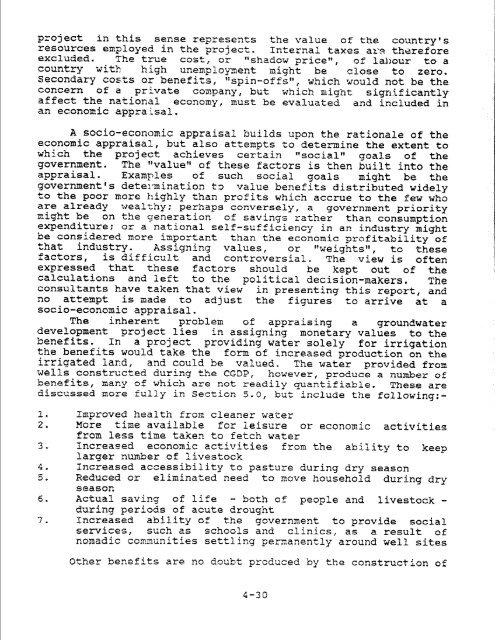r - part - usaid
r - part - usaid
r - part - usaid
You also want an ePaper? Increase the reach of your titles
YUMPU automatically turns print PDFs into web optimized ePapers that Google loves.
project in this sense represents the value of the country's<br />
resources employed in the project. Interaal taxes ax3 tharefore<br />
excluded. The *rue cost, or: qCshadow price9*, 0,' lal,our to a<br />
country with high unenplopent might be close lo zero.<br />
Secondary costs or benefits, wspin-offsH: which would not be the<br />
concern of a private company, but which night significantly<br />
affect the national economy, must be evaluated and included in<br />
an econo~ic appraisal.<br />
A socio-ecanomic appraisal Builds upon the rationale of the<br />
economic apprafszl, but also attenpts to determine the extent to<br />
which the prsject achieves certain tFsocialH goals of the<br />
government. The glvalueM of these factors is then built into the<br />
agpraisal. Examples of such social goals might be the<br />
government's dete~rmination t~ value be~efits distributed widely<br />
to the poor mare highly than profits which accrue to the few who<br />
are already wealthy; perhaps conversely, a government priority<br />
xight he on the generation of savings rather than consumption<br />
expenditure; or a national self-sufficiency in an industry might<br />
be considered more important than the economic profitability of<br />
that industry. Assigning values, or tfweightsw, to these<br />
factors, is difficult and controvexsia2. The view is often<br />
expressed that these factors should be kept out of the<br />
calculations and left to the political decision-makers, The<br />
consultants have taken that view in presenting this report, and<br />
no arternpt is made to cdjust the figures to arrive at a<br />
soeio-economic appraisal.<br />
The inherent problem of appraising a groundwater<br />
develop~ent project lies in assigning monetary values to the<br />
benefits. In a project providing water solely for irrigation<br />
the benefits would take the fam of increased produetian on the<br />
irrigated land, and could be valued. The water provided from<br />
wells constructed during the CGD2, however, prozuce a number of<br />
benefits, many of which are not readily quantifiable. These are<br />
discussed m ore fully in Section 5.0, but include the following:-<br />
Improved health from cleaner water<br />
Xore ti=@ available Ecr leisure or economic activities<br />
from less time taken to fetch water<br />
Increased economic activities from the ability to keep<br />
larger number of livestock<br />
Increased accessibility to pasture during dry season<br />
Reduced or eliminated need to move household during dry<br />
58dSOrr<br />
Actual saving of life - both of people and livestock -<br />
during periods of acute drought<br />
Increased ability of the government to provide social<br />
services, such zs scb0o3s and clinics, as a result of<br />
nomadic csnxunities settling pemanently around well sites<br />
Other benefits are n3 docbt produced by the constructlsn of

















